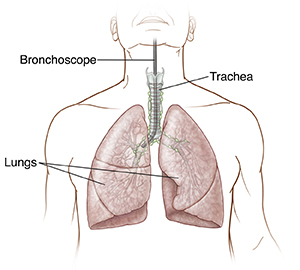Flexible Bronchoscopy
Flexible bronchoscopy is a procedure to examine the breathing airways. This test lets your healthcare provider see the inside of the airways and take tissue or mucus samples. The bronchoscope is a thin tube-shaped instrument. It's inserted through the nose or mouth. A camera at the end of the tube takes images which are then transmitted to a video screen.

Before your test
-
Follow your healthcare provider's instructions carefully. If you don’t, the exam may be canceled. Or you may need to take it again.
-
You might need blood tests before the procedure. Follow instructions from your healthcare team and keep all appointments.
-
Ask your provider if you should stop taking certain medicines before this test, especially blood-thinning medicines
-
Follow any directions you're given for not eating or drinking before the test.
-
Don't smoke for 24 hours before the test.
-
You'll need to remove any dentures or removable devices from your mouth.
-
Right before the test, you will be given sedating medicines to help you relax. The medicine may be given by an IV (intravenously) into one of your veins. In addition, your nose and throat may be numbed with a special spray to help prevent gagging and coughing.
-
If you are having this test as an outpatient, make sure you have an adult friend or family member to drive you home.
During your test
Bronchoscopy takes 45 to 60 minutes and includes the following steps:
-
You may be given medicine (anesthesia) so that you are unconscious or asleep during the procedure.
-
The healthcare provider puts the tube into your nose or mouth.
-
If you haven't been given anesthesia, you might have a gagging feeling. To help ease this feeling, you will be told to swallow or take deep breaths. Your airway will remain open even with the tube in place. But you won’t be able to talk.
-
The provider checks your airway. They may also remove tiny tissue samples for a biopsy.
After your test
-
You may have a mild sore throat or cough. Your voice may also be hoarse.
-
Don't eat or drink until the anesthesia wears off.
-
You might see very small amounts of blood being coughed up.
When to call your healthcare provider
Call your healthcare provider right away if you have any of these:
-
Bleeding from your nose or throat
-
Coughing up a large amount of blood
-
A fever above 100.4°F ( 38°C) for more than 24 hours, or as advised by your provider
-
New symptoms, symptoms that get worse, or symptoms that don't go away
When to call 911
Call 911 right away if you have:
-
Chest pain
-
Severe shortness of breath or trouble breathing
-
Fast heart rate
-
Bluish-colored skin, lips, or mouth
Online Medical Reviewer:
Chris Southard RN
Online Medical Reviewer:
Marianne Fraser MSN RN
Online Medical Reviewer:
Sravani Chintapalli
Date Last Reviewed:
3/1/2024
© 2000-2024 The StayWell Company, LLC. All rights reserved. This information is not intended as a substitute for professional medical care. Always follow your healthcare professional's instructions.